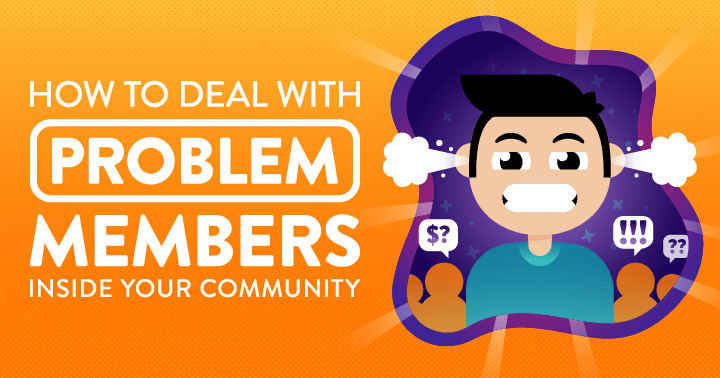One of the best things about running a membership website is that we can market and position it in a way that attracts the sort of members that we most want to work with.
However, no matter how hard you try to get only the “right type” of people in your membership, you will inevitably experience problem members.
Sometimes it will be a personality clash, where certain members just rub you up the wrong way; however there will be instances where you need to deal with potentially toxic traits among your member base.
So how do you deal with them?
Dealing with difficult members in your community is a necessary step of being a membership owner, but first you must ask yourself, is this member really a problem?
Just because they’re rubbing you the wrong way, doesn’t mean it’s time to kick them out!
The plain truth is, you don’t have to be friends with all of your members.
In fact, as your membership site grows, there will be more and more people you clash with.
With hundreds and hundreds of members, it’s unrealistic that you’ll gel with every single one of them.
But where does someone cross the line from being annoying to being a serious concern?
Well, if they’re triggering arguments, posting offensive or inappropriate materials, offending other members, or causing a number of complaints… you’ve got a problem.
Instantly Remove Major Issues
To first address the BIG issues, if a member is actively harassing or threatening other members, stealing content, or posting extremely inappropriate materials on your site, instantly remove them.
That kind of behavior doesn’t deserve a warning and should not be tolerated.
Those kinds of people can be extremely toxic.
Depending on what they’re doing, they can cause you to lose members.
Shut that down immediately.

Now, these are our tips on how to manage problem members that don't hit that high bar for instant removal from your site.
1. Distinguish Passion from Problem
When you realize you have a problem, it’s important not to overreact.
If someone is adding to a heated discussion, you don’t want to come down on them like a ton of bricks.
Your membership isn’t a totalitarian regime.
If you start banning people left and right, your members are going to be afraid to express any opinion at all.
In some markets, heated topics will come up organically.
It’s just in the nature of the subject.
Your job is to distinguish members who are passionate from those who are a problem.
2. Start with Strike One
When a member begins to cause problems in your community by causing offense and starting arguments, we recommend beginning with a warning.
Contact the member privately so the drama doesn’t play out on your forum.
Let the problem member know what the situation is.
You’ve got to be clear about the issue and your views about it.
Don’t be accusatory or stock the fire and eventually cause a bigger problem.
Make them aware of the problem and how it isn’t acceptable from your perspective.
Take a stand that this approach will not be tolerated and that the next step will be removal from the community.
3. Stay Positive
Be clear that this warning isn’t something you take pleasure in.
It’s not something you want to do. Your hope is that just making them aware that there’s been a complaint or that there’s an issue will be enough to get things back on a positive track.
Approach it with a positive mindset. It may well be that this person doesn’t realize how they are being perceived.
People have all sorts of different styles and attitudes.
What we see as abrasive, someone else might think funny.
They may not realize they are causing problems.
Don’t go in there with hostility.
Go in with a positive outlook and a genuine approach from the mindset that you would love to turn this around and have that person contribute in a far more positive way.
Don’t allow this private communication to evolve into a nasty argument.
4. Monitor Behavior
Unfortunately, problem members don’t disappear with just a warning.
You need to be actively monitoring their activity after the warning is delivered.
If you’re using something like Active Campaign, Ontraport, or Infusionsoft where you have site tracking enabled, take a look at what pages are they going to.
For example, if you give someone a warning and then you see that they’re going through every single piece of content on your website and it looks like they’re downloading everything and they’re planning on running off, that might prompt you into taking some sort of action.
5. Cancel and Remove
When it comes time to finally kick out that problem member, our best advice is to cancel and remove access to your website before you let them know that is happening.
This strategy will help safeguard yourself from potential fallout.
Cancel their subscription with your membership plugin and payment processor.
You don’t want them to be accidentally billed later.
You may also want to consider refunding their most recent payment.
Sure, it can be a financial hit, but it limits the blowback from your problem member.
Some people will want the whole sum of what they paid refunded, but they don’t really have a case for that because they will have had full access to what they paid for during that time.
If someone is paying you on an annual basis, you might want to think of doing a prorated refund.
This is to again reduce blowback and reduce any question of whether there‘s a legal issue about you not providing what’s been paid for.
Ensure there is something in your terms and conditions for your membership that makes it clear you can revoke access at anytime.
Ultimately, you need to protect your membership community, and it is in your right to do so.
It’s so crucial to maintain harmony within your community and to do that, you’ve got to remember you set the rules.
It’s important that you take action when you have people who want to disrupt that harmony and threaten your business through their negative behaviors.
So if you’ve been struggling with a problem member, hopefully this will give you some guidance on how to deal with it.






